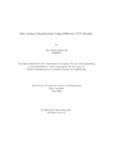| dc.contributor.advisor | Chakrabarty, Amitabha | |
| dc.contributor.author | Oli, Md. Yahea Sultan | |
| dc.date.accessioned | 2023-09-25T06:35:21Z | |
| dc.date.available | 2023-09-25T06:35:21Z | |
| dc.date.copyright | 2023 | |
| dc.date.issued | 2023-05 | |
| dc.identifier.other | ID 19166012 | |
| dc.identifier.uri | http://hdl.handle.net/10361/21229 | |
| dc.description | This project report is submitted in partial fulfillment of the requirements for the degree of Master of Science in Computer Science and Engineering, 2023. | en_US |
| dc.description | Cataloged from PDF version of the project report. | |
| dc.description | Includes bibliographical references (pages 38-40). | |
| dc.description.abstract | The field of dermatoscopic image classification has gained significant attention as
there is a growing demand for early diagnosis of specific diseases. The use of deep
learning is increasingly significant in the quest for a more effective dermoscopic anal-
ysis method. The “HAM10000” (Human Against Machine) dataset has been used in
this study for classification of 7 different types of skin lesions by using DenseNet-121,
VGG16, ResNet50, and Inceptionv3 model. To improve the classifier’s performance,
data augmentation was applied. This study could help dermatologists in the clinic
make more precise decisions when identifying skin lesions, which would be benefi-
cial. With this project I have tried to improve the model so that dermatologists
identify skin lesions more precisely. Through the implementation of data augmen-
tation techniques, this project achieved an impressive categorical accuracy of 92%
and a top2 accuracy of 97% using DenseNet-121. The remaining models, VGG16,
ResNet50, Inceptionv3 achieved accuracy 80%, 78%, 84% respectively. This project
could have a beneficial impact on dermatoscopic image recognition and can reduce
time and valuable resources. It can also help to saves life where robust diagnosing
is not available. | en_US |
| dc.description.statementofresponsibility | Md. Yahea Sultan Oli | |
| dc.format.extent | 50 pages | |
| dc.language.iso | en | en_US |
| dc.publisher | Brac University | en_US |
| dc.rights | Brac University project reports are protected by copyright. They may be viewed from this source for any purpose, but reproduction or distribution in any format is prohibited without written permission. | |
| dc.subject | Cancer | en_US |
| dc.subject | Distinguished | en_US |
| dc.subject | Melanoma | en_US |
| dc.subject | Lesion | en_US |
| dc.subject | Densenet121 | en_US |
| dc.subject | VGG16 | en_US |
| dc.subject | In- ceptionv3 | en_US |
| dc.subject | ResNet50 | en_US |
| dc.subject.lcsh | Computer algorithms | |
| dc.subject.lcsh | Pattern recognition systems | |
| dc.subject.lcsh | Neural networks (Computer science) | |
| dc.title | Skin lesion classification using different CNN models | en_US |
| dc.type | Project report | en_US |
| dc.contributor.department | Department of Computer Science and Engineering, Brac University | |
| dc.description.degree | M. Computer Science and Engineering | |

